The “dream house” nightmare
 Wednesday, December 14, 2011 at 05:46PM
Wednesday, December 14, 2011 at 05:46PM Cité Soleil, Dec. 14, 2011 – While over one million refugees suffered under tents following the January 12, 2010, earthquake, 128 newly constructed homes, finished in May, 2010, sat empty for 15 months.
Today, the majority of these “social housing” units are occupied, but mostly by illegal squatters who broke in by smashing windows and doors.
“The houses have been finished for almost two years, but they have never been officially delivered,” Jean Robert Charles, one of Cité Soleil’s assistant mayors told Haiti Grassroots Watch (HGW).
The 128 homes – dream houses compared to where the majority of Haitians live – are in Zoranje, a region of Cité Soleil northeast of the Port-au-Prince metropolitan region. With two bedrooms, a bathroom, a living room, kitchen/dining room and a little yard, they are a gift from the Venezuelan government.
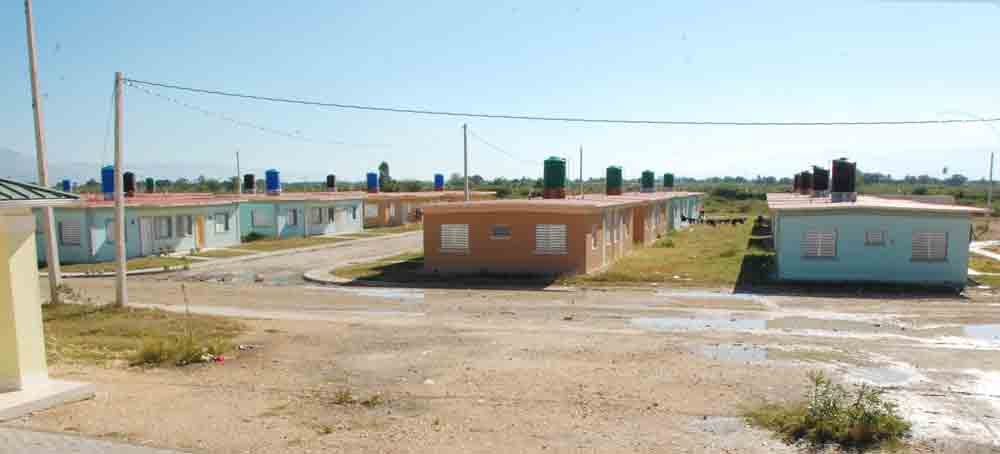
A view of some of the "dream houses." Photo: James Alexis
The project cost US$4.9 million, according to a Cuban newspaper writing about the donation in 2010. They are part of a gift of 500 homes promised in March, 2007, by Venezuelan President Hugo Chavez during a visit to Haiti. A Cuban-Venezuelan firm linked to the Bolivarian Alliance of the Americas (ALBA) cooperation partnership built the houses, according to the same article.
Venezuela is one of Haiti’s most important partners. Among other examples of cooperation, the country sells Haiti gasoline at a preferential price. After the earthquake, with a pledge of US$1.3 million, Venezuela promised more assistance than another other country, even surpassing the pledge from the U.S.
However, it appears the social housing project at Zoranje is something of an embarrassment to the government. On many occasions, HGW tried to obtain an interview with the Venezuelan embassy in the capital. Due to promises not kept and rendezvous missed, the interview never took place.
This might be due to the fact that the homes were only finally occupied in September, 2011, 18 months after Venezuela handed over the first 88 homes to the René Préval government. And because, apart from the 42 families chosen by the embassy, the majority of the homes – at least 50 – are occupied by squatters.
All is not peaceful in the “dream houses”
Forty-two of the 128 housing units were distributed by the Ambassador of Venezuela. The beneficiaries have papers dated September 5, 2011, confirming the deliveries, and all of them told HGW they are victims of the earthquake, from three distinct groups: people working for the embassy, people recommended by a women’s organization, and finally people recommended by a congregational school.
“Venezuela gave 42 homes to people who needed homes” Dolciné Marie Joseph, head of the women’s group, told HGW. She moved in with her children.
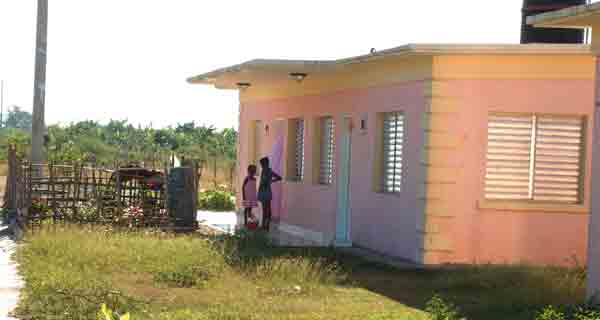
Marie Joseph's home. She preferred not to have her photo taken. Photo: James Alexis
But despite the generous character of the gift, and the obvious advantages of her new home, everyday life is in fact bitter, Marie Joseph said, because dozens of families have invaded the rest of the apartments.
“We haven’t had a coup d’état in the country. I really disapprove of this. What these people have done, moving in without permission, is really bad,” she said indignantly.
According to the Marie Joseph, there are thieves among the squatters.
“They invade the apartments and they have stolen a water pump, [although they couldn’t] take the pump’s motor because it’s underground,” she added. But without the pump, water cannot be pumped up into the water reservoirs that sit on the houses roofs.
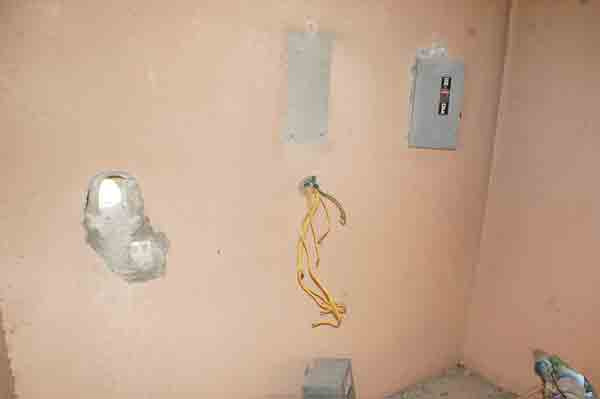
The one of the pump rooms. Photo: James Alexis
HGW journalists saw evidence of other vandalism and damage, also: broken mirrors, stolen locks, smashed doors. According to the Cité Soleil mayor, “Even toilets have been stolen.”
Not surprisingly, there is tension between the two groups of residents.
The squatters say they grew tired of “living under tents,” and they told HGW they refuse to be kicked out by the authorities. Several times already, police have tried to dislodge the squatters, but each time they moved back into the homes.
“I have two sons who died in the January 12 earthquake, and I don’t have a home. The mayor thought we didn’t deserve houses,” said Martine Janvier, an elderly woman.
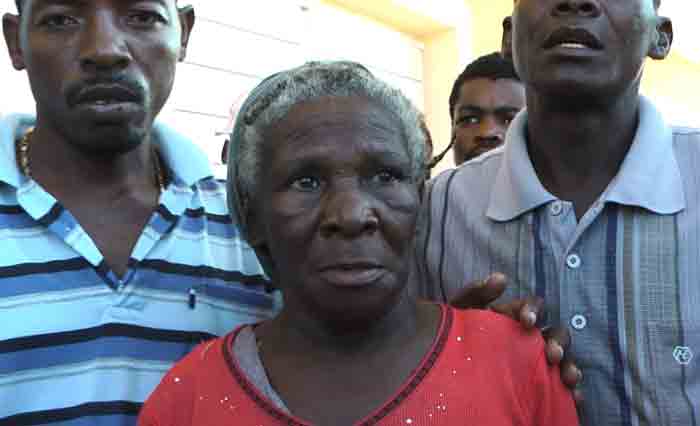
Martine Janvier. Photo: HGW
In the middle of the jubilant crowd of mostly women, another, Jésula Aristène asked out loud, as she held up a copy of the Universal Declaration of Human Rights: “Doesn’t the Haitian state owe us social housing?”
Disagreement and disorganization
The 128 anti-earthquake apartments – painted cream, rose and green – sat empty for a long time because of dissention between the Haitian and Venezuelan governments, according to many sources interviewed by HGW.
The two sides of the partnership – the donor and the recipient – could not agree on the eventual beneficiaries of the project and of the eventual management structure: the “who” and the “how.
A number of authorities contacted by HGW refused to speak on the record, and they all said they did not know who in the Préval government (2005-2011) was in charge of the dossier. However, all unanimously told the same story about the disagreement and the lack of coordination.
A person working on the housing issue at the Interim Haitian Recovery Commission (IHRC) said that, in correspondence with HGW last September, that: “The Venezuelan government and the Haitian government did not agree on how to choose the beneficiaries.”
According to the same source, Venezuela wanted to give the houses to people who were living in the Cité Soleil slum, but the Haitian government didn’t agree.
“The Haitian government argued that the zone wasn’t appropriate for poor people because it lacks work and public services,” the source said.
Questioned about the future of the houses, a member of the Michel Martelly government, who also asked to remain anonymous, said: “We don’t know why the previous administration didn’t make them available to the population. We want to integrate them into the housing stock of the 16/6 project.”
The 16/6 project aims to rehabilitate 16 Port-au-Prince neighborhoods and enable 5,000 families living in six camps to return to their communities of origin. The project costs US$78 million.
According to the Martelly government, “Venezuela reserved and delivered 42 homes to beneficiaries that it identified. Apart from these 42, all the other occupants are illegal.”
Elonge Othélot, the general director of the government Public Entity for the Promotion of Social Housing (Entreprise Publique de Promotion de Logements Sociaux - EPPLS) – the only state agency charged with constructing and managing housing – is not in charge of the Venezuela houses, and was not involved in the discussions between Haitian and Venezuelan authorities. Contacted by HGW, he said he knew that “the project was finished,” but that there had been confusion.
“Maybe the management roles haven’t been determined yet?” he asked himself.
Othélot said that he “approached the First Secretary at the Venezuelan embassy” about the issue. “But, he hasn’t followed up with me to figure out the management question,” he continued.
“The Venezuelans need to decide how they are going to deal with this,” he concluded.
Mayor Charles goes much further. During interviews with HGW, he didn’t mince words when criticizing the representatives of Venezuela in Haiti and the way they have handled the dossier, which he qualified as “disorder.”
Venezuelan authorities refused to speak with HGW on the issue, despite several attempts and one visit to the embassy.
What is the future for the project and the squatters?
The member of the Martelly government said that, for the moment, “the project is being managed by Cité Soleil City Hall,” but he also added that the government is “in the process of setting up a management platform that will be headed by [Colonel Jacques] Azémar,” a former U.S. army officer of Haitian origin.
“We are in the discussions with the mayor’s office and with other government entities like EPPLS so that we can find a way to integrate the different communities” at Zoranje, the source added.
However, Gustave Benoit, another assistant mayor for Cité Soleil contacted on December 9 by HGW, said he is unaware of any implication of Col. Azémar. To the contrary, his office is working with the Ministry of the Women’s Condition and Rights in order to decide the fate of the squatters.
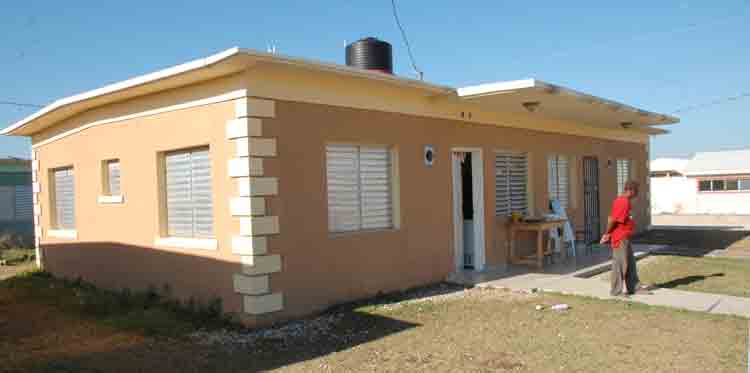
A man in front of his new home. Photo: James Alexis
There are other housing installations near the Venezuela project. Renaissance Village, an apartment complex built by the Jean-Bertrand Aristide government, is currently more or less self-managed according to testimony collected at the site, and a third project, “400 in 100,” aims to build 400 homes with financing from the Inter-American Development Bank.
EPPLS is supposedly responsible for building and managing housing projects, but after January 12, it seems, the agency has been kept out of the reconstruction scene. But the state agency – which is itself miserably housed in a small run-down building – is not involved in any of the major housing projects.
“EPPLS doesn’t have a budget that is up to the task,” Othélot explained.

EPPLS parking lot and office. Photo: HGW
The rusting hulks of cars and trucks in the parking lot bear witness to his words. For this reason – and perhaps others – most of the housing projects EPPLS has built in the past have escaped its control, like the Renaissance Village. Residents rarely pay rent to the state, and in most cases, EPPLS doesn’t even know the names of the tenants.
For the moment, the Venezuela houses appear to be following the same path.


Reader Comments